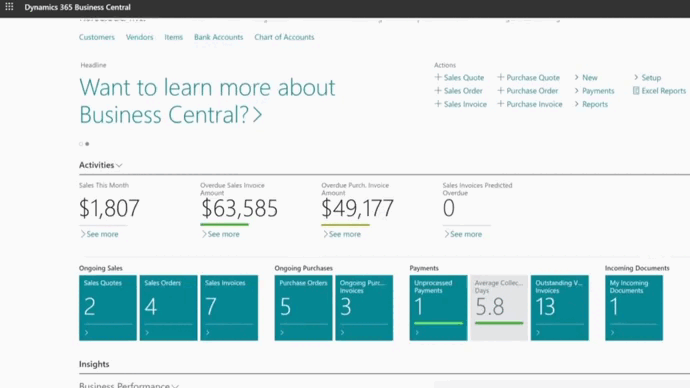Choosing between Odoo and Microsoft Dynamics 365 Business Central isn’t just a software decision — it’s a strategic investment that shapes how your organization will operate, scale, and compete in the years ahead. Both platforms have strong reputations in the SMB ERP market, but they’re built on fundamentally different philosophies: one prioritizes open-source flexibility, while the other is engineered for long-term stability, structured growth, and integration with the Microsoft cloud ecosystem.
In this in-depth comparison, we’ll break down everything you need to know about Odoo vs Business Central in 2025 — pricing, customization, integrations, AI features, reporting, financials, industry fit, and total cost of ownership. You’ll also get a clear recommendation on which system matches your organization’s size, complexity, and digital transformation goals.
Quick answer: Odoo vs Business Central (2025)
If you’re in a hurry, here’s the summary:
- Choose Odoo if you’re a small business (under 20 users), have simple workflows, a limited budget, and internal developers who can maintain customizations.
- Choose Business Central if you’re a growing SMB (25–500 employees), need reliable financials, advanced reporting, AI-powered automation, multi-entity management, and deep integration with Microsoft 365, Power BI, and the Power Platform.
For most organizations planning to scale, Business Central offers a more predictable roadmap, stronger reporting, better upgradeability, and a far richer ecosystem.
You do not know which one to choose between Odoo and Business Central?
Contact us for a deep overview of Business Central and discover why this is the best choice for businesses who want to expand and grow.
 Free discovery call
Free discovery call
Now, let’s explore both platforms in detail.
Odoo vs Business Central: comparison at a glance (2025)
Best for
Deployment
Customization
Integrations
AI features
Financials
Manufacturing
Reporting
Total cost of ownership
Ideal users
Small businesses, startups
Cloud or on-premise
Depp-code level (open source)
Third-party apps, APIs
Limited, module-based
Basic to moderate
Good for simple MRP
Basic without customization
Low year 1, higher long-term
1–25 users
Growing SMBs
Cloud-native SaaS
Extension-based, upgrade-safe
Microsoft ecosystem
Copilot
Advanced, audit-ready
Good for light/mid manufacturing
Power BI native + advanced financials
Higher year 1, lower long-term
25–500+ users
What is Odoo?

Odoo is an open-source, modular ERP and business application suite known for its flexibility and low entry cost. It includes dozens of apps — CRM, accounting, manufacturing, inventory, eCommerce, marketing, HR — all available à la carte.
Strengths of Odoo
- Extremely flexible and customizable
- Attractive pricing for small teams
- Massive marketplace of community modules
- Quickly deployable for simple use cases
- Easy to start, especially for non-regulated environments
Limitations of Odoo
- Custom code breaks upgrades
- Developer dependency increases over time
- Reporting and financials often require additional modules
- Data model not as unified as traditional ERP systems
- Quality of community apps varies widely
- Limited enterprise-grade AI, automation, and governance
Who it’s best for:
Startups and small businesses with simple operations, low budgets, and internal technical resources.
What is Business Central?

Dynamics 365 Business Central is Microsoft’s cloud-native ERP designed for growing small and medium-sized businesses. It covers financials, supply chain, inventory, project management, basic CRM, manufacturing, and distribution— with deep integration into the Microsoft ecosystem.
Strengths of Business Central
- World-class financial management
- Cloud-native SaaS with automatic upgrades
- Powerful reporting with Power BI
- Built-in AI features (Copilot)
- Strong integrations with Microsoft 365, Teams, Outlook
- Extension-based customization that preserves upgrades
- Global partner ecosystem (tens of thousands of consultants)
- Ideal for multi-entity, multi-currency, multi-region operations
Limitations of Business Central
- Higher initial licensing and implementation cost
- May require add-ons for niche industries
- Must be implemented through a partner
Who it’s best for:
Organizations that need a scalable, structured, compliant ERP system that can support growth over the next 5–10 years.
Odoo vs Business Central: key differences explained
1. Customization and flexibility
Odoo: maximum control — with long-term risks
Odoo’s open-source model gives full access to the codebase. You can customize absolutely everything — but the moment you modify core code, you risk:
- losing upgrade compatibility
- creating technical debt
- relying heavily on developers
- paying more for maintenance over time
For small companies with simple processes and internal IT talent, this flexibility can be a plus. For growing companies, it becomes a liability.
Business Central: structured, modern customization
Business Central uses “extensions,” which sit on top of the core product instead of modifying it. This guarantees:
- upgrade-safe customizations
- predictable maintenance
- faster implementations
- cleaner data models
- long-term stability
Verdict
If you need maximum flexibility and have internal developers → Odoo
If you want predictable, upgrade-safe customization → Business Central

2. Pricing: different upfront vs long-term economics
Odoo pricing model
- Low monthly license cost
- Each module costs extra
- Hosting may be extra
- Community apps vary in price
- Customization costs accumulate
- Upgrades become expensive if customized
Result: Odoo is cheaper in year 1, but often more expensive by year 3–5 due to maintenance and reimplementation work.
Business Central pricing model
- Two license levels: Essentials or Premium
- Most modules included
- Hosting included
- Upgrades automatic
- Predictable long-term cost
- Lower maintenance overhead
Result: Business Central has higher startup costs but lower long-term TCO, especially for companies planning to scale.

3. Integrations and ecosystem
Odoo
- 40,000+ community apps
- Many integrations rely on third-party developers
- API available but requires custom development
Quality varies widely — some modules are excellent, others buggy.
Business Central
- Deep integration with Microsoft 365
- Power Platform: Power BI, Automate, Dataverse
- AppSource apps are vetted, secure, enterprise-grade
This creates a predictable, secure, scalable integration environment.
Verdict: For businesses in the Microsoft ecosystem (Teams, Outlook, Excel, SharePoint, Power BI):
Business Central is the clear winner.
How much can you save?
Download your free Excel calculator to find out how much savings you can make by implementing Business Central today.

4. AI & automation (critical for 2025)
Business Central
Microsoft has invested massively in AI, giving BC:
- Copilot for forecasting, reporting, anomaly detection
- Power Automate for workflow automation
- AI-enhanced reconciliation
- Predictive Cash Flow
- Natural language reporting
This is a major differentiator no competitor article emphasizes enough.
Odoo
- Limited native AI
- Some modules claim AI features but require customization or third-party apps
- Lacks enterprise-grade AI automation
Verdict: Business Central leads AI and automation by a large margin.

5. Financial management depth
This is where the differences become significant.
Business Central strengths
- Multi-entity, multi-currency
- Consolidations
- Budgeting and forecasting
- Advanced audit trails
- IFRS and GAAP support
- Dimensional reporting
- Power BI financial dashboards
Odoo limitations
- Good basic accounting
- Advanced finance requires additional modules
- Limited consolidation
- Not ideal for audit-heavy industries
Verdict: For finance-led organizations → Business Central is the superior choice.

6. Manufacturing and inventory management
Odoo
- Excellent module diversity
- Good for simple to moderate manufacturing
- Multi-level BOM, routings, work orders
- Risk: custom workflows break upgrades
Business Central
- Strong for light to mid manufacturing
- Add-ons available for advanced MRP
- Robust supply chain and warehouse logic
Verdict:
For small shops → Odoo
For standardized or scaling manufacturing → Business Central

7. Reporting & business intelligence
Business Central
- Power BI native
- Real-time dashboards
- Embedded analytics
- Excel integrations
- Copilot for report generation
Odoo
- Basic reports out of the box
- Customization needed for advanced dashboards
- Limited analytics unless using add-ons
Verdict: If reporting is important → Business Central wins easily.
Book your free consultation with our ERP experts
Undecided between Odoo and Business Central? Let our experts guide you in your choice and show you why Business Central is the best choice for your company.
 Free discovery call
Free discovery call
8. Scalability & company size
Odoo’s sweet spot
- 5–25 employees
- 3–10 ERP users
- Simple inventory, simple MRP
- Early-stage companies
Business Central’s sweet spot
- 25–500+ employees
- Multi-location, multi-entity
- Growing teams
- Companies preparing for the next 10 years
Verdict: If you’re planning to scale → Business Central is the long-term solution.
Industry breakdown: Odoo vs Business Central
Manufacturing
- Odoo = highly flexible, great for small manufacturers
- BC = structured manufacturing, excellent when paired with MRP add-ons
Distribution & inventory
- BC’s warehouse logic (bins, license plates, waves) is superior
- Odoo fits small warehouses
Professional services
- BC integrates with Office 365, Teams, Outlook, PSA
- Odoo lacks advanced project accounting
Retail & eCommerce
- Odoo has built-in website + eCommerce
- BC integrates better with enterprise platforms (Shopify, Magento, POS systems)
Nonprofit / public sector
- BC supports compliance and secure cloud environments
- Odoo not widely used in regulated industries

Which companies should choose Odoo?
Choose Odoo if:
- You have fewer than 20 ERP users
- You’re a startup or early-stage SMB
- You need fast deployment
- You have internal developers
- You need low upfront costs
- Your processes are simple
Which companies should choose Business Central?
Choose Business Central if:
- You plan to scale
- You need audit-ready financials
- You rely on Microsoft 365
- You need strong reporting and BI
- You operate in multiple locations or entities
- You need a system that won’t break with upgrades
- You want AI capabilities (Copilot) built in
Odoo vs Business Central pricing (detailed)
Odoo
- $20–$45/user/month (depending on modules)
- Each functional area costs extra
- Hosting may cost extra
- Support often outsourced
- Customization drives long-term cost upward
- Upgrades can require reimplementation
Business Central
- $109/user/month for Essentials
- $150/user/month for Premium
- All core modules included
- Hosting included
- Predictable annual cost
- Partner support available
Conclusion
Odoo is cheaper in the short term.
Business Central is cheaper and more stable in the long term.
Total cost of ownership (5-year comparison)
Small (5 users)
Growing SMB (20 users)
Large SMB (50+ users
Less expensive
Higher maintenance burden
Very high long-term cost
Higher cost
More cost-efficient
Cheaper, more scalable
Why many Odoo users eventually migrate to Business Central
- They outgrow Odoo’s financials
- Reporting limitations
- Too many customizations
- Upgrade & version-control issues
- Multi-entity needs
- Need for structured workflows
- Integration gaps
- Move to Microsoft cloud ecosystem
It’s a common progression:
Odoo → QuickBooks alternative → Business Central when the business matures.
Speak with our experts now
Let us guide you in your choice of ERP software by showcasing the strengths of Business Central and how our team can help with the integration.
 Free discovery call
Free discovery call
Why partner with Gestisoft for Business Central?
Gestisoft has been implementing ERP and CRM solutions for over 25 years. As a trusted Microsoft partner, we help growing organizations:
- Modernize their ERP systems
- Migrate from platforms like Odoo, SAP, Sage, or QuickBooks
- Streamline operations with Business Central
- Build dashboards, automation, and AI capabilities
- Support long-term scalability
With local expertise, a proven methodology, and deep manufacturing/distribution knowledge, we guide your team through a smooth, strategic ERP transition.
-
Yes, Odoo has a lower entry cost. But long-term maintenance, customizations, and upgrades often make it more expensive after a few years.
Conclusion: Odoo vs Business Central — which ERP should you choose?
Both Odoo and Business Central are excellent ERP platforms — but designed for very different stages of business maturity.
- Choose Odoo if you’re a small business with simple needs and a tight budget.
- Choose Business Central if you’re planning to scale, need reliable financials, want AI-powered automation, or require deep integration with Microsoft 365.
If your organization is already using Excel, Teams, Outlook, Power BI, or SharePoint, the long-term strategic value of Business Central becomes even stronger.
As your business grows, the need for structure, reporting, governance, and automation grows with it. For this reason, Business Central is the better long-term choice for most SMBs preparing for their next stage of digital transformation.
Liked what you just read? Sharing is caring.

November 24, 2025 by Kooldeep Sahye by Kooldeep Sahye Marketing Specialist
Fuelled by a passion for everything that has to do with search engine optimization, keywords and optimization of content. And an avid copywriter who thrives on storytelling and impactful content.
